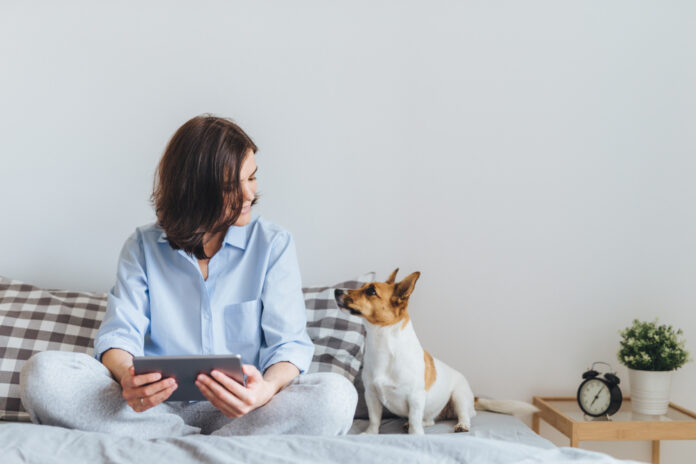Bringing a pet into your home is an exciting and joyful experience. However, it also comes with the responsibility of ensuring that your living space is safe and comfortable for your new furry friend. Transforming your home into a pet-friendly haven doesn’t mean sacrificing style or cleanliness. With thoughtful planning and some clever adjustments, you can create an environment where both you and your pet can thrive.
View Your Home from Your Pet’s Perspective
To begin, it’s essential to see your home through your pet’s eyes. This means getting down to their level and identifying potential hazards that might not be obvious from an adult’s viewpoint. Look for small objects that could be choking hazards, dangling cords that pose strangulation risks, and spaces where a curious pet might get stuck.
Eliminate Household Hazards
Pets are naturally curious and may explore areas or items that are dangerous. Keep all toxic substances like cleaning supplies, pesticides, and certain foods out of reach. Store these items in high cabinets or use childproof locks to prevent access. Medications, both prescription and over-the-counter, should also be securely stored away.
Remember that some houseplants can be toxic to pets. Common plants like lilies, tulips, and poinsettias can be harmful if ingested. Ensure that all plants within your pet’s reach are safe or place toxic plants in areas inaccessible to them.
Choose Pet-Friendly Furniture and Fabrics
When it comes to furnishings, opt for materials that are both durable and easy to clean. Leather and microfiber fabrics are excellent choices for pet owners. Leather is resistant to stains and can withstand wear and tear, while microfiber does not have loops that can snag on claws.
Avoid delicate fabrics like silk or velvet, which can be easily damaged by pets. Additionally, consider furniture with removable, washable covers to make cleaning easier.
Opt for Pet-Friendly Flooring
Flooring is another important consideration. Hard surfaces like stone, vinyl, or painted concrete are ideal for pet-friendly homes because they resist scratches and are easy to clean. If you prefer carpets or rugs, select those with low piles and consider colors that match your pet’s fur to minimize the appearance of pet hair.
Create Designated Pet Areas
Designate specific areas for your pet equipped with all their essentials. This can include a cozy bed, water and food bowls, and safe toys to keep them entertained. Having a dedicated space helps your pet feel secure and can reduce the likelihood of them exploring and potentially damaging other parts of your home.
Secure Trash and Food Storage
Pets are often tempted by the smells coming from trash cans or food storage areas. Use pet-proof trash cans with secure lids and store food in cabinets or containers that your pet cannot open. This prevents them from ingesting something harmful and keeps your kitchen tidy.
Protect Electrical Cords and Outlets
Secure all electrical cords and cover outlets to prevent pets from chewing on them or getting shocked. You can use cord protectors or hide cords behind furniture to make them inaccessible.
Pet-Proof Your Outdoor Spaces
If your pet has access to outdoor areas, ensure these spaces are safe and secure. Install sturdy fencing to prevent escapes and check regularly for any gaps or weak spots. Provide shaded areas and fresh water so your pet can stay cool and hydrated. Be mindful of outdoor plants, as some can be toxic if ingested.
Prepare for Emergencies
Having a pet first aid kit is crucial. Keep essential items like adhesive tape, antibacterial ointment, and hydrogen peroxide on hand in case of minor injuries. Consult your veterinarian on what to include and the correct dosages for your pet.
Regular Cleaning and Maintenance
Maintaining a clean home is part of pet ownership. Regular grooming and bathing reduce the amount of pet hair and dander in your home. Invest in a high-quality vacuum cleaner designed for pet hair. Use enzyme-based cleaners to remove stains and odors effectively.
Provide Mental and Physical Stimulation
Pets need exercise and mental stimulation to stay healthy and happy. Create engaging environments like agility courses for dogs or window perches for cats. Providing appropriate toys and activities can prevent boredom and reduce destructive behaviors.
Consider Your Pet’s Specific Needs
Every pet is different, and their needs may vary. For example, senior pets may benefit from orthopedic beds or ramps to help them navigate your home. Smaller pets or those with special needs might require additional safety measures.
Conclusion
Creating a pet-friendly and safe home involves a combination of thoughtful planning, proactive safety measures, and regular maintenance. By considering your pet’s perspective and needs, you can design a living space that is enjoyable for both you and your pet. With these steps, you ensure that your home remains a sanctuary where all members of the household can live harmoniously.


